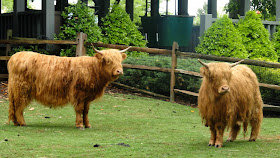 |
| Chincoteague, VA. Photo by Debi Lander. |
Rugged men, resourceful women, wild ponies running free and oysters worth slurping occupy the Eastern Shore year 'round. Off-islanders visit when the water warms and the weather is better along this 70-mile-long pointy finger of a peninsula from Kiptopeke in the south to the bottom half of Assateague Island to the north.
You know this peninsula with the longest stretch of undeveloped barrier islands on the East Coast (23) has to be worth visiting when you consider the effort and expense of building and maintaining the Chesapeake Bay Bridge-Tunnel connecting it to the mainland. The 17-mile-long creation is considered one of the seven engineering marvels of the world.
 |
| Barrier Island Center. Photo © by Judy Wells. |
One road stretches like a spine from end to end of the peninsula, giving residents a simple way to identify their locale: baysider or seasider, up the road or down the road. Our first stop was
The Barrier Island Center in Machipongo, an enjoyable way to learn what life on barrier islands was like.
Westerners have been settling here since the 1600s. Early cash crops were
salt and wool. The salt came from the ocean and settlers found a cheap
and easy way to control sheep for the wool: maroon them on smaller
barrier islands where they could forage for themselves. Today the descendents of those 17th century sheep are adding to the historical accuracy of Colonial Williamsburg and Mount Vernon.
By the 1800s rich northerners were flocking to
Hog Island for the hunting and fishing.
 |
| Hog Island Hotel desk. Photo © by Judy Wells. |
A large part of the center's displays are dedicated to the community of watermen on Hog
Island
that was washed away and deserted following a storm in the 1930s.
From
the Hog Island Hotel front desk and the watermen's boats to locally
carved wooden decoys and the annual July Fourth baseball games and the
recipes for food to fuel them, displays emphasize personal lifestyles.
 |
| The 17th century cook house, left, and what had been the African-American women's housing. Photo © by Judy Wells. | |
The Center's building comes with its own history having served as the Almshouse Farm since 1803. Machipongo, by the way, is an Indian word meaning place of fine dust and flies. It was windy during our visit which kept the flies down and the thriving grass took care of the fine dust.

If, like Judy, you grew up on Newberry Award-winner
Marguerite Henry's books and fell in Love with "Misty of Chincoteague," the
Museum of Chincoteague
will be a must stop.
The protagonist of that book is stuffed and on display as is Stormy,
her third and last foal. So are other mementos of life on Chincoteague,
but after the Center you will have seen much of that already. You may leave
wishing you had kept going with only Wesley Dennis's illustrations of
Misty, but go ahead and stop anyway.
 |
| Stormy |
 |
| Misty |
 |
| View from the Visitors Center. Photo © by Judy Wells. |
We went to the
Chincoteague National Wildlife Refuge to look for the real things, the wild ponies that live on Assateague Island. The popular myth is that they were washed ashore from a capsized Spanish galleon, but genetics indicate they were of domestic stock that were put on the islands to escape a livestock tax and turned feral over the centuries.
 |
| Chincoteague ponies. |
After checking with the National Park Service Visitors Center at Little Toms Cove, we found a threesome in the distance while driving along the Wildlife Loop Road, where we also encountered bird watchers sitting in lawn chairs to watch an eagle's nest.
 |
| One very preggnant mare and a Misty look-alike. Photo by Debi Lander. |
 |
| Denise Bowden, |
We heard a lot more about the ponies during dinner at
Don's Seafood where we met
Denise Bowden, the first woman accepted into the
Chincoteague Volunteer Fire Company. The company owns and is allowed to graze the 150 ponies on the Virginia end of Assateague. Some 30-40 ponies live on the Maryland end of Assateague, their numbers controlled by artificial birth control.
 |
| Fairgrounds. |
Since the early 1940s, said Denise, the Chincoteague firemen have auctioned off young ponies as a way to control the size of the herd and to raise money for equipment. The round up, swim from Assateague to Chincoteague, pony penning, auction and carnival are held the last consecutive Tuesday and Wednesday of July. Preliminaries - rounding up the herds, walking them to the assembly area and checking the ponies for health and destiny - fills Saturday through Tuesday. The swim takes place on Wednesday, the auction on Thursday, Friday the ponies swim back to Assateague and, as Denise says, "Saturday we fall out."
Easily understood when a town of 3,000 hosts 50,000 or more visitors.
 |
| Make way for ducks and ducklings. |
It's easy to see how Chincoteague has been voted happiest town, best seaside town and other hospitality and lifestyle kudos over the years. Ducks have the right-of-way, locals are surrounded by sea and bay with all of its bounty, the wild things that live or visit are respected and residents live at a pace that fits with tides and ducks.
 |
| Kayakers in Assateague Channel. |
There is room for all, even the human tourists who flock to their
beaches, paddle in their waters, come to observe wildlife, clog
restaurants and streets of this half-mile-wide, seven-mile-long island.
Even when visitors push ordinary out-the-door lines at the Island Creamery to a length that anywhere else would engender wait-rage, the locals smile.
Marsh mud, an unbelievably dense chocolate, is worth the wait and they know when the winds blow as cold as the locally made ice cream inside, the island will be theirs again.











































